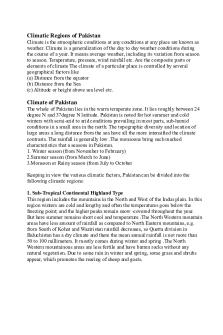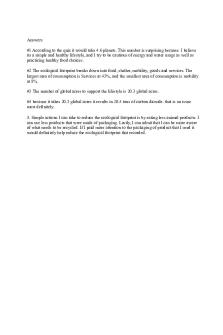AGRO ECOLOGICAL REGIONS OF INDIA PDF

| Title | AGRO ECOLOGICAL REGIONS OF INDIA |
|---|---|
| Course | Geography |
| Institution | University of Delhi |
| Pages | 5 |
| File Size | 379.1 KB |
| File Type | |
| Total Downloads | 38 |
| Total Views | 150 |
Summary
consists of the basics of agro ecology along with its important elements and the 20 major regions along with their major characteristics given in a comprehensive form of a table...
Description
UNIT II: 1. AGRO ECOLOGICAL ZONES- REGIONALISATION OF INDI Agro-climatic zone is a land unit in terms of major climate, superimposed on length of growing period (m 1983) whereas an agro-ecological zone is the land unit carved out of agro climatic zone superimposed on la climate and length of growing period. An Agro-ecological Cell (AEC) is defined by a unique combination of landform, soil and climatic char processing unit for physical analysis in an AEZ study. The essential elements in defining an agro-ecological zone (or cell) are the growing period, temperature regime
ELEMENTS LENGTH OF GROWING PERIOD: period during the year when prevailing temperature are conducive to crop growth (tmean>5 C) and preciptation + moisture stored in the soil profile exceed half the potential evapo transpiration rate(PET).The growing period defines the period of the year when both moisture and temperature conditions are suitable for crop production. can be interrupted by a) a dry break b) dormancy or cold break. an LGP interrupted by dormancy is considered as 1 Growning Petiod
THERMAL REGIME
SOIL MAPPING UNIT
The thermal regime refers to the amount of heat available for plant growth and development during the growing period. It is usually defined by the mean daily temperature during the growing period
Year round growing period: in an all year round humid period P> PET for the whole year
Normal Growing Period: P> PET for one part of the year. distinguished as: 1. 1GP 2. 1GP with 1 dormancy period 3. 2or more GPs 4. 2 or more GPs of which one with Dormancy period
The soil mapping unit is the basic unit taken from the soil map. When the various soils of a soil mapping unit occur in a recognizable geographical pattern in defined proportions, they constitute a soil associations. Land, according to the FAO definition includes climate, but soil includes properties of the land surface but excludes climate.
ECOSYS
REGIONS
TEM
ARID
States
ECO
Represented
REGION
1.Western
Jammu
Himalayas
Kashmir
and Cold arid &
Himachal
SOIL TYPE
LGP
Shallow
The area qualifies Mild
skeletal,
for
calcareous
moisture and cryic mean
Pradesh
AGRO CLIMATE
aridic
soil
soil severe
summers,
LAN
Spar
winters, non annual 11.1
temperature temperature
less 2.5%
regime with LGP2 than 8 C, rainfall
pulse
of less than 90 less than 150 mm
fruit
days in a year.
apric pash shee
The
ecosystem
represents
2.Western
Gujarat,
Hot Arid
plain. Katch Rajasthan,
Desert
aridic
Rain
soil moisture and
crop
and hyperthermic soil Mean
saline
temperature
annual mille
precipitation
less
(fodd
and part of Punjab
regimes with an than 400mm.
grow
Kathiawar
annual
area
,Haryana
peninsula
LGP
of
less than 90 days
cotto must whea irrig tropi fores redu 1%)
3.deccan plateau
AP, Karnataka
Hot arid
Red and black
The
climate
characterized hot
and
is The
rainfall
is
rainf
by erratic and ranges ,cult dry from 400 to 500
mille
summer and mild mm.
seaso
winter. The LGP
sorg
i
f l
th
90
ffl
highlands
Haryana
pige
including
Rabi
aravallis
lenti mille whea regio vege dry d
5.
central Gujarat, MP
Hot
(Malwa)
semi Medium
arid
and
90-150 days a year
”
Dryl
deep black
Khar
highlands,
sorg
Gujarat
pige
plains,
rabi
Kathiawar
sunf
peninsula
Dry
6.deccan
Karnataka,
AP,
plateau
MP, Maharashtra
Hot semi arid
Shallow
and
90-150
600-1000mm
medium black
Rain drou distr rainf crop durin Sept on st mois decid fores
7.
Deccan AP
Hot
(telangana)
semi Red and black
”
Rain
”
Khar
arid
plateau and
rice,
eastern ghats
decid fores
8.
Eastern Karnataka,
ghats, tamil Kerala
TN,
Hot semi arid
Red loamy
”
”
Rain mille
Pige Khar decid
10.
Central MP, Maharashtra
highlands
Hot
sub Black & red
”
1000-1500 mm
humid
Rain pige
(Malwa,
Rabi
Bundhelkha
tropi
nd,
decid
&
eastern satpura)
11.eastern
MP
plateau
Hot sub
Red and
humid
yellow soils
150-180 days
1200-1600mm
Rain Khar
(chhattisgarh
pige
)
black mois fores
12.Eastern
Orissa, WB,
Hot sub
Red
(chota
Bihar, MP,
humid
laterite
nagpur)
Maharashtra
and
”
1000-1600mm
Rain pulse Trop
plateau and
mois
Eastern
fores
ghats
13.
eastern UP, Bihar
plains
Hot humid
sub
Alluvium
180-210 days
1400-1800 mm
derived
Rain maiz pea Rabi sesam Cash suga chill
14. western MP, UP, J &K
Warm
himalayas
humid
sub Brown forest & podzolic
1000-2000mm
Rain horti plan othe etc
16.
Eastern WB,
himalayas
Sikkim,
Aru Pradesh
Warm
per Brown
humid
red hill
and
270 days
2000mm
Jhum culti must in terra tea, a
17.
north Tripura
, Warm
eastern hills Mizoram, (purvanchal)
per Red
humid
and
Exceeds 270 days
2000-3000mm
lateritic
Jhum rice-
Meghalaya
mille in te altitu valle seaso
COASTA
18.
Eastern Tamil
nadu, Hot
L
coastal
puducherry, AP, humid
plains
Orissa, WB
sub Coastal
90- 150 days
900-1100mm
to alluvium
semi arid
Rain agric
derived
dom eco of brac fishe
19. western Kerala, ghats
ISLAND
goa, Hot
& Maharashtra,
coastal
Gujarat,
plains
and diu
humid Red, lateritic
per humid
daman
20. Island of Andaman
and Hot
Andaman
and per humid
Nicobar
150-210 days
Exceeds 2000 mm
Inten
and alluvium
rice,
derived
& sp
humid Red , loamy and sandy
Exceeds 210 days
900-1100 mm
Natu tropi
and Nicobar Lakshadweep
and
and
plan
Lakshadwee
dom
p
coco...
Similar Free PDFs

AGRO ECOLOGICAL REGIONS OF INDIA
- 5 Pages

Climatic Regions of Pakistan
- 2 Pages

Ecological theories of crime
- 4 Pages

Ecological Consideration of Site
- 81 Pages

Ecological footprint
- 1 Pages

Visita Porto Agro
- 2 Pages

MCQ history of India
- 4 Pages

Iconomics of india report
- 3 Pages

Festivals of India
- 4 Pages

Politics of India - Wikipedia
- 9 Pages

Natural Vegetation Of India
- 4 Pages

Lesson 5 A World of Regions
- 3 Pages

Golden Harvest Agro Industries Ltd
- 14 Pages

Ecological Succession
- 4 Pages

Ecological Succession
- 5 Pages
Popular Institutions
- Tinajero National High School - Annex
- Politeknik Caltex Riau
- Yokohama City University
- SGT University
- University of Al-Qadisiyah
- Divine Word College of Vigan
- Techniek College Rotterdam
- Universidade de Santiago
- Universiti Teknologi MARA Cawangan Johor Kampus Pasir Gudang
- Poltekkes Kemenkes Yogyakarta
- Baguio City National High School
- Colegio san marcos
- preparatoria uno
- Centro de Bachillerato Tecnológico Industrial y de Servicios No. 107
- Dalian Maritime University
- Quang Trung Secondary School
- Colegio Tecnológico en Informática
- Corporación Regional de Educación Superior
- Grupo CEDVA
- Dar Al Uloom University
- Centro de Estudios Preuniversitarios de la Universidad Nacional de Ingeniería
- 上智大学
- Aakash International School, Nuna Majara
- San Felipe Neri Catholic School
- Kang Chiao International School - New Taipei City
- Misamis Occidental National High School
- Institución Educativa Escuela Normal Juan Ladrilleros
- Kolehiyo ng Pantukan
- Batanes State College
- Instituto Continental
- Sekolah Menengah Kejuruan Kesehatan Kaltara (Tarakan)
- Colegio de La Inmaculada Concepcion - Cebu
